
The Sultanate of Sulu was a Muslim state that ruled the Sulu Archipelago, costal areas of Zamboanga City and certain portions of Palawan in the today's Philippines, alongside parts of present-day Sabah, North and East Kalimantan in north-eastern Borneo.

The Tausūg, are an ethnic group of the Philippines and Malaysia. A small population can also be found in the northern part of North Kalimantan, Indonesia. The Tausūg are part of the wider political identity of Muslim Filipinos of western Mindanao, the Sulu archipelago, and southern Palawan, collectively referred to as the Moro people. The Tausugs originally had an independent state known as the Sultanate of Sulu, which once exercised sovereignty over the present day provinces of Basilan, Palawan, Sulu, Tawi-Tawi, Zamboanga City, North Kalimantan and the eastern part of the Malaysian state of Sabah. They are also known in the Malay language as Suluk.
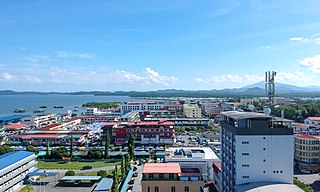
Lahad Datu is the capital of the Lahad Datu District in the Dent Peninsula on Tawau Division of Sabah, Malaysia. Its population was estimated to be around 27,887 in 2010. The town is surrounded by stretches of cocoa and palm oil plantations. It is also an important timber exporting port. The town has an airport for domestic flights.

Sandakan formerly known at various times as Elopura, is the capital of the Sandakan District in Sabah, Malaysia. It is the second largest city in Sabah after Kota Kinabalu. It is located on the Sandakan Peninsula and east coast of the state in the administrative centre of Sandakan Division and was the former capital of British North Borneo. In 2010, the city had an estimated population of 157,330 while the overall municipal area had a total population of 396,290. The population of the municipal area had increased to 439,050 by the 2020 Census.
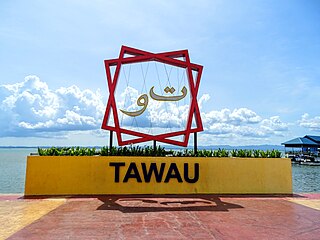
Tawau, formerly known as Tawao, is the capital of the Tawau District in Sabah, Malaysia. It is the third-largest city in Sabah, after Kota Kinabalu and Sandakan. It is located on the Semporna Peninsula in the southeast coast of the state in the administrative centre of Tawau Division, which is bordered by the Sulu Sea to the east, the Celebes Sea to the south at Cowie Bay and shares a border with North Kalimantan, Indonesia. The town had an estimated population as of 2010, of 113,809, while the whole municipality area had a population of 397,673. The municipal area had a population of 372,615 at the 2020 Census.
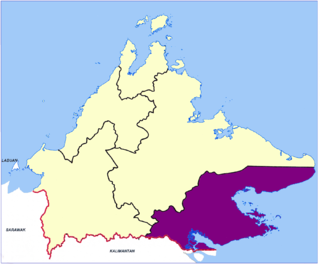
Tawau Division is one of the five administrative sub-divisions of Sabah, Malaysia. It occupies a total of 14,905 square kilometres or 20% of Sabah's territory. The main towns include the capital of Tawau, Lahad Datu, Kunak and Semporna. Tawau division has 26% of Sabah's total population, with the main indigenous groups consisting of the Bajau, Suluk, Ida'an, Tidong, Cocos, Murut, Lun Bawang/Lun Dayeh as well as a minority of mixed ethnic groups. Large numbers of both legal and illegal immigrants from Indonesia such as the Buginese and Torajans, from East Timor the Timorese, from the Philippines the Tausūg and Visayans as well South and West Asian immigrants such as Pakistanis, Indians and Arabs can be found in this area. As with the rest of Sabah, the division also has large numbers of ethnic Chinese.

Semporna is the capital of the Semporna District in the Tawau Division of Sabah, Malaysia. Its population was estimated to be around 35,301 in 2010.

The North Borneo dispute, also known as the Sabah dispute, is the territorial dispute between Malaysia and the Philippines over much of the eastern part of the state of Sabah. Sabah was previously known as North Borneo prior to the formation of the Malaysian federation.
Jamalul ibni Punjungan Kiram III was a former self-proclaimed Sultan of the Sulu Sultanate who claimed to be "the poorest sultan in the world". He was known as an unsuccessful candidate for senator in the Philippine general elections in 2007. In 2013, Kiram III sparked a controversy when he revived a dispute between the Philippines and Malaysia by leading an intrusion into the eastern part of Sabah. His daughter is Princess Jacel Kiram, a proponent of the Sabah claim of the Philippines in 2016.
The Filipino Malaysians consists of people of full or partial Filipino descent who were born in or immigrated to Malaysia. Filipinos in Malaysia comprise migrants and residents from the Philippines and their descendants living in Malaysia. Because of the short distance between the two nations, many Filipinos mainly from Mindanao have migrated to the Malaysian state of Sabah to escape from the conflict, poverty and in search for better lives. About 325,089 Filipinos live in Malaysia. Many of them are illegal residents while there are a smaller number of migrant workers and fewer permanent residents.
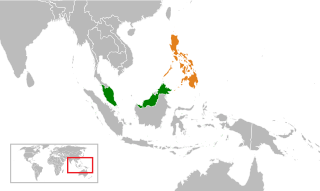
Malaysia–Philippines relations refers to the bilateral relations between Malaysia and the Philippines. The Philippines has an embassy in Kuala Lumpur, and Malaysia has an embassy in Manila and a consulate general in Davao City. The people of the two neighbouring countries have a long history of cultural and political relations.

The history of Sabah can be traced back to about 23–30,000 years ago when evidence suggests the earliest human settlement in the region existed. The history is interwoven with the history of Brunei and the history of Malaysia, which Sabah was previously part of and is currently part of respectively. The earliest recorded history of Sabah being part of any organised civilisation began in the early 15th century during the thriving era of the Sultanate of Brunei. Prior to this, early inhabitants of the land lived in predominantly tribal societies, although such tribal societies had continued to exist until the 1900s. The eastern part of Sabah was ceded to the Sultan of Sulu by the Sultan of Brunei in 1658 for the former helping a victory over Brunei enemies, but many sources stated it had not been ceded at all. By the late 19th century, both territories previously owned by Sultan of Brunei and Sultan of Sulu was granted to British syndicate and later emerged as British North Borneo under the management of the North Borneo Chartered Company. Sabah became a protectorate of the United Kingdom in 1888 and subsequently became a Crown colony from 1946 until 1963, during which time it was known as Crown Colony of North Borneo. On 16 September 1963, Sabah merged with Malaya, Sarawak and Singapore to form Malaysia.
Ismael ibni Punjungan Kiram II was a self-proclaimed Sultan of the Sultanate of Sulu from 12 March 2001 until his death on 19 September 2015.

The 2013 Lahad Datu standoff, also known as the Lahad Datu incursion or Operation Daulat, was a military conflict in Lahad Datu, Malaysia. The conflict began on 11 February, when 235 militants arrived in Lahad Datu by boat, and ended on 24 March. The militants, who called themselves the "Royal Security Forces of the Sultanate of Sulu and North Borneo", were sent by a claimant to the throne of the Sultanate of Sulu.
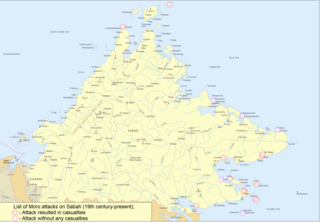
The cross border attacks in Sabah are a series of cross border terrorist attacks perpetrated by Moro pirates from Mindanao, Philippines, in the state of Sabah, Malaysia, that began even before the British colonial period. Many civilians have died or suffered during these incidents, causing an increase in anti-Filipino sentiment among the native peoples of Sabah, especially after major attacks in 1985, 2000 and 2013. The attacks were more intense during the presidential terms of Diosdado Macapagal and Ferdinand Marcos, who supported irredentist claims to include eastern Sabah as part of the Philippines territory. In addition, recent infiltration and attacks by militants as well as uncontrolled human migration from Mindanao to Sabah has led to more unease sentiments among the local residents of Sabah, with around 78% of prison inmates that were caught in the state due to involvement in criminal activities and lawlessness issues mainly originating from the southern Philippines.
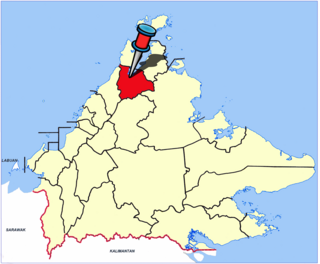
The Kota Marudu District is an administrative district in the Malaysian state of Sabah, part of the Kudat Division which includes the districts of Kota Marudu, Kudat and Pitas. The capital of the district is in Kota Marudu Town.
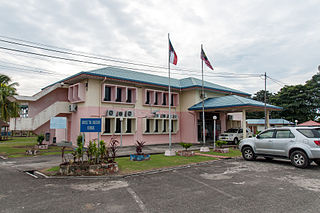
The Kunak District is an administrative district in the Malaysian state of Sabah, part of the Tawau Division which includes the districts of Kunak, Lahad Datu, Semporna and Tawau. The capital of the district is in Kunak Town. Kunak district were part of Lahad Datu before 1990.

The Semporna District is an administrative district in the Malaysian state of Sabah, part of the Tawau Division which includes the districts of Kunak, Lahad Datu, Semporna and Tawau. The capital of the district is in Semporna Town.

The Tawau District is an administrative district in the Malaysian state of Sabah, part of the Tawau Division which also includes the districts of Kunak, Lahad Datu, Semporna and Tawau. The capital of the district is in Tawau Town. The district also includes the northern half of Sebatik Island, which is shared with Indonesia's North Kalimantan province.

The Papar District is an administrative district in the Malaysian state of Sabah, part of the West Coast Division which includes the districts of Kota Belud, Kota Kinabalu, Papar, Penampang, Putatan, Ranau and Tuaran. The capital of the district is in Papar Town.




























